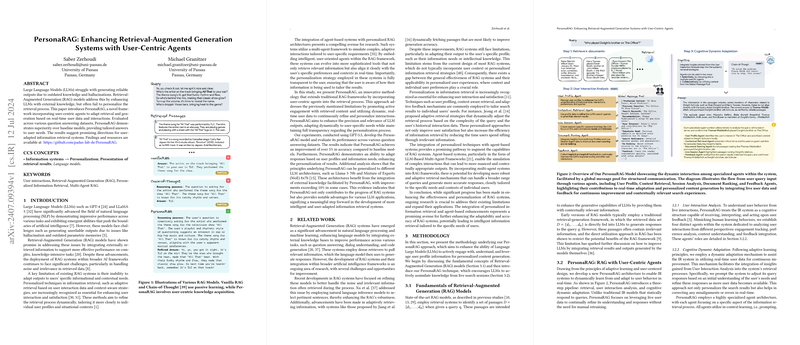PersonaRAG: Enhancing Retrieval-Augmented Generation Systems with User-Centric Agents
Overview
The paper "PersonaRAG: Enhancing Retrieval-Augmented Generation Systems with User-Centric Agents" by Zerhoudi and Granitzer proposes a novel framework for improving Retrieval-Augmented Generation (RAG) models. These models aim to address limitations of LLMs such as outdated knowledge and hallucinations by leveraging external information retrieved from large corpora. PersonaRAG enhances traditional RAG systems through the incorporation of user-centric agents that dynamically adapt retrieval and generation based on real-time user data and interactions.
Methodology
PersonaRAG distinguishes itself by focusing on personalization and user-centric adaptation. The proposed architecture employs a multi-agent system, where each agent specializes in different aspects of the retrieval and generation process. The system involves a three-step workflow: retrieval, user interaction analysis, and cognitive dynamic adaptation.
User Interaction Analysis
The user interaction analysis is executed by four dedicated agents:
- User Profile Agent: Manages historical interaction data and user preferences.
- Contextual Retrieval Agent: Adjusts search queries and prioritizes results based on user profiles.
- Live Session Agent: Analyzes user actions in real-time to update session-specific contexts.
- Document Ranking Agent: Ranks retrieved documents by integrating insights from other agents.
These agents collectively work to provide an understanding of the user's informational needs and preferences, facilitating a more personalized retrieval process.
Cognitive Dynamic Adaptation
Building on analysis from the interaction agents, the cognitive dynamic adaptation mechanism refines the retrieval and generation process in real-time. This mechanism allows the system to dynamically adjust its responses, ensuring that the generated content is highly relevant and tailored to the user's immediate context and long-term preferences.
Experimental Results
The paper presents a comprehensive evaluation of PersonaRAG against several baseline models using datasets such as NaturalQuestions (NQ), TriviaQA, and WebQuestions (WebQ). The experiments demonstrate that PersonaRAG significantly outperforms both vanilla RAG models and baseline LLMs without retrieval augmentation.
- In particular, PersonaRAG achieved up to a 10% improvement over vanilla RAG models across several datasets.
- PersonaRAG displayed robust performance by maintaining accuracy regardless of the number of retrieved passages, suggesting that fewer passages sufficed for accurate answer generation due to efficient extraction by user-centric agents.
Further, comparative analysis via BLEU-2 scores and post-hoc analyses (average sentence length and syllable count) indicated that PersonaRAG consistently generates responses that align more closely with user needs.
Generalization and Practical Implications
PersonaRAG's methodology extended successfully to other LLMs, such as LLaMA 3 70B and MoE 8x7B models, demonstrating performance improvements exceeding 10% in some cases. This suggests that the proposed framework can be generalized to various architectures, enhancing RAG systems' adaptability and accuracy.
Implications and Future Directions
The incorporation of user-centric agents within RAG systems represents a meaningful advancement in the development of personalized information retrieval frameworks. Practically, this approach could lead to more efficient and user-tailored information search experiences, enhancing user satisfaction and engagement.
Theoretically, the paper sets a precedent for future research to explore deeper user behavior modeling and more complex multi-agent interactions. Future improvements may involve optimizing the agent-based system to minimize latency and computational costs, and expanding the model to capture more granular aspects of user preferences and behaviors.
In conclusion, PersonaRAG demonstrates a significant step forward in enhancing the capability of RAG systems to provide personalized, contextually relevant responses by integrating dynamic, real-time user data with sophisticated retrieval and generation mechanisms. This approach could revolutionize the way LLMs interact with external knowledge sources and adapt to user-specific needs, paving the way for more intuitive and effective AI systems.
